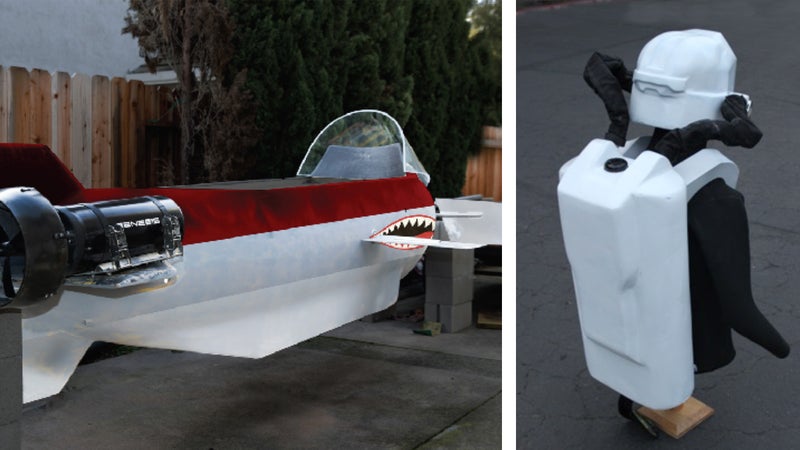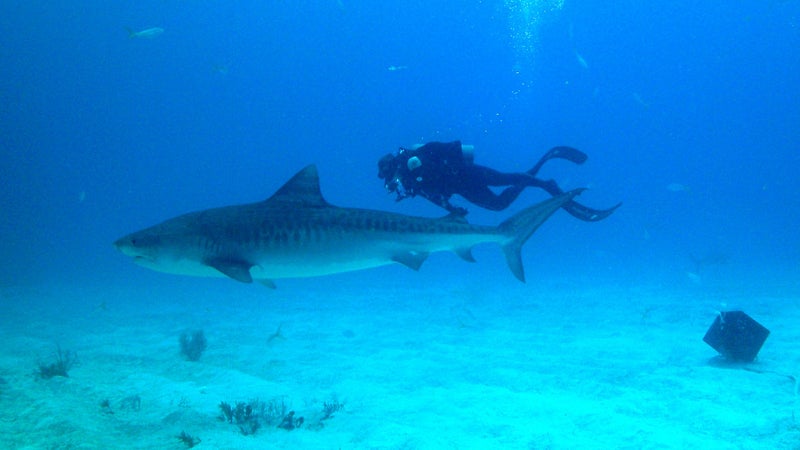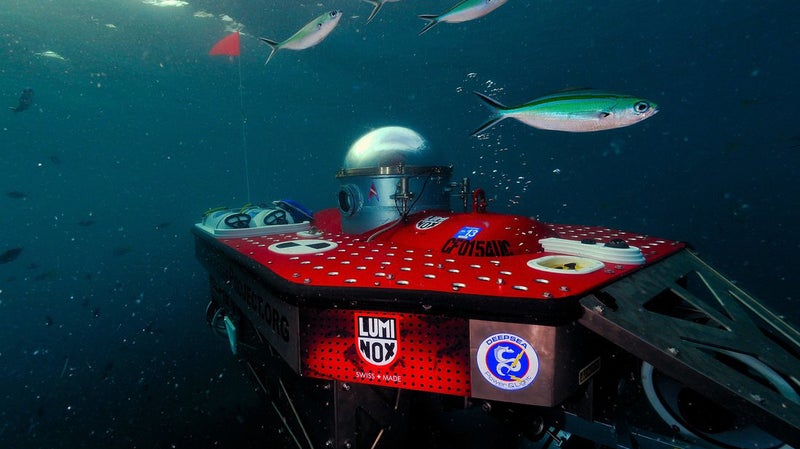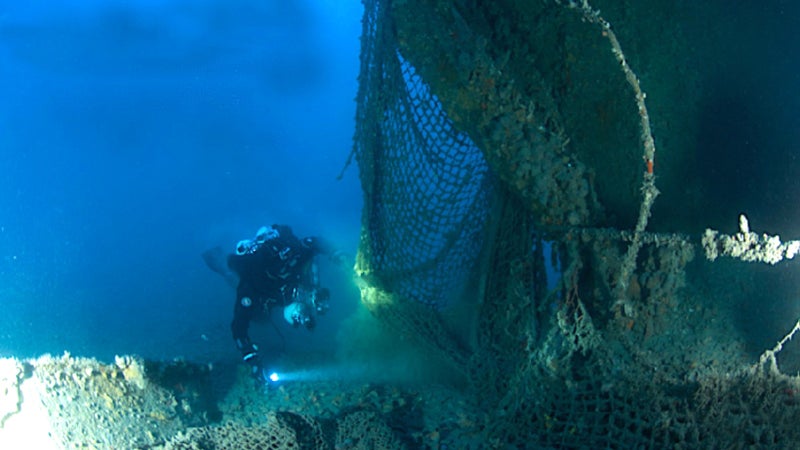Sea Change
Undersea explorer Scott Cassell is on a mission to bring the ocean’s mysteries to the surface.
It all happened pretty quickly. Five minutes after diving into the warm waters off the coast of Baja in the Sea of Cortez, a swarm of five-foot-long Humboldt squids attacked. They smashed his camera into his face, wrapped a tentacle around his arm, and bit him on the wrist. Then, the beasts dragged him deeper into the abyss so fast that his eardrum imploded from the pressure. After somehow freeing himself and getting back to the surface, Cassell, who was working as an undersea cameraman at the time, wasn’t frightened. His shoulder was dislocated, and he was more than a bit roughed up. But he was also hooked. The experience, as violent as it was, was also transcendent. He had finally found his true calling, that of an undersea explorer out to find answers to what goes on under the world’s seas.
Fast-forward 20 years, and Cassell, now 55, has spent the past two decades diving, filming, producing, and sometimes even starring in various shows about ocean life for National Geographic, BBC, Discovery Channel, Animal Planet, and History Channel, including a return to Baja to film the squids. He turned a boyish fascination with Jacques Cousteau into a 30-plus-year diving career that’s seen him spend more than 15,000 hours underwater. That works out to nearly two years of his life. He’s been a Special Operations combat diver and holds the record for the longest distance traveled underwater by a diver: 52 miles. One would think he’s seen it all, but he’s quick to tell you that 98 percent of the ocean is still unexplored.
According to Cassell, a big reason for the blank space in humanity’s knowledge of the ocean is technology. The stuff we need to explore the ocean is often too expensive for the scientific community to obtain—much like rocketing into space, going underwater requires specialized, purpose-built equipment. Hence the Underwater Voyager Project (UVP), the multifaceted nonprofit Cassell founded in 2005, which has two main goals: to create some of the most advanced scuba gear and submersibles in the water and to team up with oceanographers and marine biologists to advance our understanding of the deep.

“All professions—climbers, doctors, scientists—require their own essential gear,” Cassell says. “Mine is just as complicated.” And homemade. Between raising money and awareness for UVP and diving, he can often be found in his garage tinkering with exotic gear or sanding the fiberglass hulls of his latest submersible.
From that tinkering, he’s developed an armored, electrified underwater dive suit to protect him from the aforementioned giant squids. He’s also working on what he’s dubbed Wolf Packs: diving helmets and tanks in hard plastic cases with built-in lights to help team members keep track of each other, modeled after, of all things, the battle suits from the video game Halo. He’s also teamed up with several engineers and technicians to build a manned submarine, Great White, which can transport and support two divers working outside the vessel for up to three hours through 50-foot-long air hoses.

Right now he’s finishing up work on the Sea Wolf, an open-cockpit sub with a roll cage on top that carries three hours' worth of extra air tanks. It looks more like a jet fighter than a sub, which, in a way, it is. “We built it to ‘fly’ up to 300 feet underwater at six knots per hour (roughly seven mph) and turn and move like a big fish,” he says. In this case, the big fish are great white sharks that he plans to observe and follow for dozens of miles off the coast of San Francisco later this year.
“The idea is to travel with a shark at shark speed and give scientists the opportunity to see how they travel. Up until now, observing sharks has always been about getting them to come to us,” he says. “We really have no idea how they operate on their own—and if we have a permit to tag one along the way, we can.” Cassell even painted the Sea Wolf in sharklike camo: white underbelly, gray above, and a red strip up top, which makes it easy for humans to spot from the water’s surface but is seen as gray when underwater.

All of this technology is being developed and tested to pull off the UVP's ever-growing list of missions. “I get a question that needs an answer, and then I go to work on figuring out what inventions I need to find an answer,” says Cassell, who collaborates with a constantly expanding network of scientists from places such as San Diego’s Scripps Institute of Oceanography and Cal State East Bay. He averages 10 missions a year if he has the funding, ranging from the aforementioned tracking of great white sharks to mapping the floor of Fallen Leaf Lake, an alpine body of water south of Lake Tahoe where he believes geothermal vents on the lake bottom could be hosting freshwater life forms that no one’s ever witnessed.

But his biggest mission, one he concedes he’ll never finish, is the systematic removal of “ghost nets” from the waters offshore of California and Oregon. “We use our submarine, Great White, to go down to depths of 300 feet, looking for drift nets that either came loose on the open ocean and drifted into shallower water or were snagged on reefs and ripped free and now lie off the coast where they’re trapping and killing sea mammals and sea life by the thousands,” Cassell says. With his team and sub, he’ll be able to survey several miles per dive, cataloging and pulling the nets and fishing lines from the water.
If UVP’s lofty goals, all the James Bond-like equipment, and even Cassell’s Special Forces background all sound like ingredients for an incredible action movie with an altruistic hero at its heart, you’re probably right. And maybe it'll happen someday. But as Cassell crosses into middle age, he’s most focused on inspiring the next generation. “I’m looking for today’s and tomorrow’s heroes who are selflessly trying to do something to benefit the ocean’s health.”
Luminox shares Scott Cassell’s concern for the viability of the oceans and is honored to partner with him by helping to fund both of his organizations. Working together, Luminox and Cassell have created the Scott Cassell Deep Dive Automatic Special Edition and the Scott Cassell Special Edition Dive sets. Proceeds from the sale of these watches help support the work of Sea Wolves Unlimited and the Underwater Voyager Project. For more information, visit .


